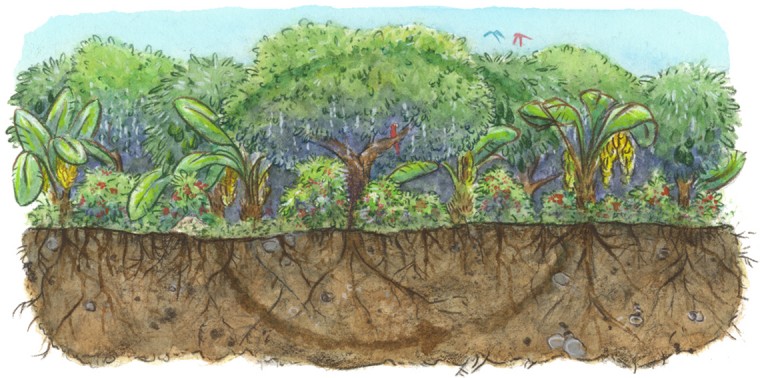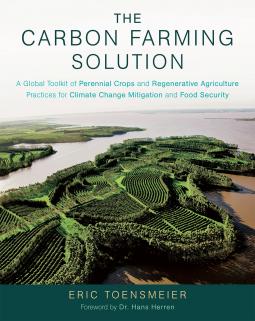Source: greenbiz.com
Published: March 26, 2016

The following is adapted from The Carbon Farming Solution: A Global Toolkit of Perennial Crops and Regenerative Agriculture Practices for Climate Change Mitigation and Food Security by Eric Toensmeier (2016). The book introduces the concept of carbon farming, explains how it can help mitigate climate change, and explores strategies for adoption around the world. Published with permission from Chelsea Green Publishing.
High in the mountains of Veracruz, Mexico, a small cooperative is “farming carbon” — practicing agriculture in a way that fights climate change while simultaneously meeting human needs.
Although these practices are used by millions of people around the world in some way, people in Western nations are largely unfamiliar with them, and there is little coordinated support to encourage farmers to adopt them.
But if supported, implemented and developed on a global scale in conjunction with a massive reduction in fossil fuel emissions, these “carbon farming” practices — a suite of crops and practices that sequester carbon while simultaneously meeting human needs — could play a critical role in preventing catastrophic climate change by removing carbon from the atmosphere and safely storing it in soils and perennial vegetation.
The cloud forest region of Veracruz, Mexico, is a humid tropical highland ecosystem that combines a mostly temperate canopy of trees such as oaks and hickories encrusted with epiphytic ferns, orchids and bromeliads with an understory of mostly tropical vegetation such as cannas, wild taros, passion fruits and tree ferns. But the cloud forest is disappearing. Between 70 and 90 percent of it has been deforested, and what remains is highly fragmented, with only tiny pockets of old growth. Much of the former forest is degraded pasture.

Many people in this region are farmers. Cattle and coffee are the primary products. Neither provides much income, and cattle farming as practiced degrades the soil.
Ricardo Romero of Las Cañadas, the small cooperative described above, is working to develop food production systems that provide a complete diet while incorporating as much of the ecosystem function of the cloud forest as possible. Such systems could also serve as corridors to reconnect fragments of intact forest. And it could do all this while sequestering impressive amounts of carbon.
Romero and his team are doing something very important beyond practicing small-scale sustainable agriculture, fostering community self-reliance, creating jobs, improving biodiversity and bringing degraded land back to life. In 1988 Romero began managing the site for pastured cattle. Over the ensuing seasons, he observed the continued degradation of the soils and ecosystem functions.
Degraded soils give up much of their carbon to the atmosphere as carbon dioxide, a greenhouse gas. In 1995 he sold his cows and undertook an impressive ecological restoration effort, propagating and planting 50,000 native trees on 60 hectares (148 acres) while allowing another 40 hectares (99 acres) to regenerate naturally. This was the beginning of an ecotourism enterprise that included tours of an awe-inspiring old-growth cloud forest.
Romero also planted native trees on 22 hectares (54 acres) of the remaining pasture and carefully reintroduced cattle. This system, called silvopasture, combines livestock production with the ecological benefits of trees, including soil regeneration.
Romero and his team are doing something very important beyond practicing small-scale sustainable agriculture, fostering community self-reliance, creating jobs, improving biodiversity and bringing degraded land back to life. These same practices sequester carbon, making Las Cañadas a showcase of some of the world’s best climate mitigation techniques.
Many forms
The term carbon farming is used to describe a suite of crops and agricultural practices that sequester carbon in the soil and perennial biomass. If widely implemented, these practices have the capacity to sequester hundreds of billions of tons of carbon from the atmosphere in the coming decades. Unlike high-tech geoengineering strategies, these practices can also feed people, build more fertile soils and contribute to ecosystem health.
Las Cañadas practices managed grazing, fodder banks and silvopasture — all of which have been shown to sequester carbon. Carbon farming can take many forms. First and simplest are modifications to annual crop production to reverse the loss of soil carbon from tillage.
For example, Las Cañadas practices biointensive crop production with very high yields in small spaces through sophisticated organic techniques. Practices like this have been found to sequester more carbon than even the best conventional annual cropping systems. The larger milpas, or crop fields, demonstrate carbon-sequestering agroecological approaches to production of maize, beans and soybeans, including crop rotation, cover crops and contour hedgerows.
Although these practices have a fairly low carbon sequestration rate, they are widely applicable and easily adopted and thus have great global mitigation potential.
Certain livestock systems also constitute carbon farming. These systems are climate friendly even when we account for methane releases. For example, Las Cañadas practices managed grazing, fodder banks and silvopasture — all of which have been shown to sequester carbon. Improved livestock production models typically have a low to moderate carbon sequestration on a per-area basis, but like improved annual cropping systems, they don’t require people to change their diets. Given that more than two-thirds of global farmland is pasture, there is great potential to scale up these practices to mitigate climate change.
It is perennial crops, however, that offer the highest potential of any food production system to sequester carbon, especially when they are grown in diverse, multi-layered systems. With their plant nursery and seed company, Romero has assembled a world-class collection of perennial crops for their climate with a special focus on perennial staple crops, analogs to maize and beans that grow on trees, vines, palms and herbaceous perennials. The cooperative has also planted a highly diverse edible forest of these species in a system called multistrata agroforestry — the gold standard of biodiversity and carbon sequestration in agriculture.
Carbon farming alone is not enough to avoid catastrophic climate change. … But it does belong at the center of our transformation as a civilization. All that said, producing food, growing industrial materials and sequestering carbon is not enough for a 21st-century farmer. Agriculture must also adapt to a changing climate.
Las Cañadas has a stated goal to “establish production systems that are resilient to prolonged droughts, excessive rains, floods or abnormal frosts.” Although carbon farming practices aren’t necessarily adaptive, in practice almost all of them are. Among the agricultural adaptation techniques on display at Las Cañadas are increases in soil organic matter, crop diversification and livestock integration.
At present, the tropics have stronger carbon farming options than colder climates; many of the agroforestry techniques that have the highest sequestration rates are largely confined to the tropics, and most of the best perennial crops available today are also native to, or grown best in, the tropics. The head start the tropics have on carbon farming provides an excellent opportunity for wealthy countries to repay climate debt by bankrolling mitigation, adaptation and development projects in the Global South and to take lessons from the endeavors already under way there.
Carbon farming alone is not enough to avoid catastrophic climate change, even if it were practiced on every square meter of farmland. But it does belong at the center of our transformation as a civilization.
Along with new economic priorities, a massive switch to clean energy, and other big changes to the way our societies work, carbon farming offers a pathway out of destruction and a route to hope. Along the way it can help address food insecurity, injustice, environmental degradation and some of the core problems with the global food system.
